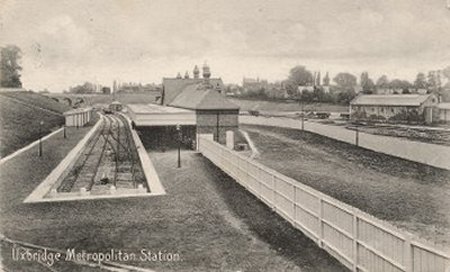METROPOLIITAN RAILWAY CENTENARY
To mark the opening of the Harrow and Uxbridge Railway in the summer of 1904, the Company issued a booklet entitled a
"Descriptive Sketch" of the line. To mark the centenary of this event we print some paragraphs from this commemorative booklet.

The Harrow and Uxbridge Railway is intended to be worked electrically, and has the
distinction of being one of the first sections of standard railway in Great Britain
laid out from the outset for electric traction. The power will be obtained from the
Metropolitan Company's extensive generating station at Neasden, which is rapidly
approaching completion; but as current will not be available immediately on the opening
of the new line, the train service will be worked for a short time by steam traction
with ordinary rolling stock.
The Harrow and Uxbridge Railway leaves the Baker Street to Aylesbury line of the
Metropolitan Railway about half a mile west of Harrow. Rayner's Lane Junction is a mile
from here, and at this point the line is joined by the branch connecting with the District
Railway at South Harrow, which is also a mile in length, mostly laid on viaduct. Uxbridge
Station is five miles distant from Rayner's Lane Junction, Ruislip Station being about
equidistant between these two points. The total length of the Harrow and Uxbridge line is
thus seven miles, the main line from Harrow Junction to Uxbridge being just six miles.
It may be interesting to briefly describe the chief attractions connected with the undertaking.
At Uxbridge the station buildings are ample, commodious, and withal artistic. A spacious
carriage-way leads down to the station, and access to the platform is gained by means of a
spacious booking hall, opening out of which on the one side are the ladies' waiting rooms,
and on the other the booking and parcels offices. The usual waiting rooms, lavatory, station
master's office and porters' and store rooms open on to the main platform, which will be able
to accommodate all the trains that will use the station under ordinary conditions of working.
The main platform is well sheltered by the usual verandah type of roof, with glass skylights,
and there is an additional platform, provided with a shelter, for use in case of necessity.
A commodious refreshment room has been included in the station buildings; and the red brick
used throughout in the construction imparts to the station a particularly pleasing appearance.
To the right of the passenger station a very large goods-yard with extensive sidings has been
laid out. A small covered goods station has also been erected, designed so as to be easily
extended if required. Access to the goods-yard is obtained from the highway by a cart road
quite separate from that leading to the passenger station. Goods and passenger traffic is
provided for, and the latter is capable of very great expansion, and this will no doubt take
place as the surrounding country is developed into new residential districts. As regards goods
traffic the system will, by means of the Metropolitan Railway and its connections with the
Midland Railway at Finchley Road, the Great Central Railway at Quainton Road, and the London
and North-Western Railway at Verney Junction, be brought into direct communication with all
parts of Britain.
With the exception of the long viaduct on the South Harrow branch, the only heavy work on the
line was the cutting, which is entered just after leaving Uxbridge. Only one retaining wall
has however been found necessary. The construction of the Park Road bridge, which spans this
cutting, was a somewhat difficult work. The bridge, which carries one of the main roads out
of Uxbridge over the railway, is four-arched and of handsome appearance.
Near Ruislip Station is situated the one sub-station necessary for the working of the railway.
It was built by the contractors, Messrs Bott and Stennett, and the sub-station machinery
with all electrical plant has been supplied and erected by the British Westinghouse Electric
and Manufacturing Company Limited of Norfolk Street, Strand, London, and Trafford Park,
Manchester. Provision has been made at both Uxbridge and Ruislip Stations for electric lighting,
and as soon as the power station at Neasden is working, the stations, as well as the goods yard
at Uxbridge, will be lighted by electricity.
 Click on image to read
Click on image to read
The new railway, which will be opened for public traffic on Monday, July 4th 1904, forms an
important link connecting West Middlesex with London, and should prove a great boon to the
inhabitants of Uxbridge, a town of some consequence standing fifteen miles from London on
one of the principal highways leading direct to the metropolis. A splendid district is opened
up, which should rapidly become popular as a delightful and healthful suburb of London.
Uxbridge stands just outside the Buckinghamshire border, being divided from that county only
by the river Colne, and the country around is picturesque.
* Our thanks to Ruth Simpson for making this original invitation available.
 Return To Home Page
Return To Home Page


